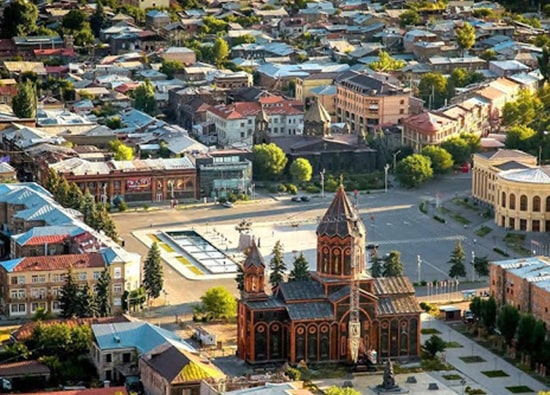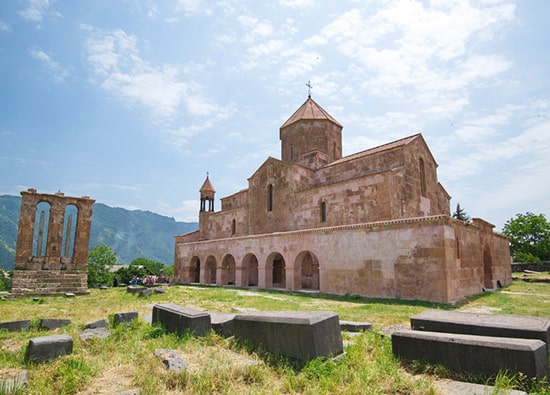Excursion to Khor Virap monastery - Noravank monastery - Areni - Tatev monastery
Duration
The length of the program 11-12 hours, excluding lunch stop (optionals, not included in the price)
Travel dates
You can choose any convenient travel dates. The trips are available all year round.
Payment
We have no prepayment. You can make payment in travel day. Entrance fees are to be paid by yourself.
Meeting point
Our employees will meet you / pick you up at the place of residence (for example in hotel, hostel or private flat), and at the end of a trip will bring you back!
Khor Virap monastery

Khor Virap is an Armenian monastery, located near the closed border with Turkey. The monastery is known for its location at the foot of biblical Mount Ararat, upon which, according to the legend, Noah appeared on the Ark after the great flood.
It is one of the shrines of the Armenian Apostolic Church, a place of pilgrimage. Translated from the Armenian, "Khor Virap" means "deep pit". The monastery is located above the underground prison, in which the Armenian King Tiridates III kept St. Gregory the Illuminator in durance.
About 14 years St. Gregory the Illuminator spent in Khor Virap. And no one knows what it all would have been ended, but Tiridates III became seriously ill. The King’s sister Khosrovidukht saw in her dream that only Grigory could heal Tiridates. So he was released. Gregory healed the king with his faith in God, after what he was baptized and made Christianity the state religion. So in 301 Armenia was the first country to adopt Christianity officially.
Areni village (Birds cave)


Areni is a village in Vayots Dzor region in Armenia. It is located in the valley of the Arpa River on its left bank. Areni is a village with rich history, at one time being the capital of Syunik. Currently, the village and its surroundings are known for their wines.
At the beginning of the 21st century, the settlement was in the focus of attention of the world mass media: during the inspection of the surrounding rocks, archaeologist B. Gasparyan discovered a cave with mummified remains of people of the Eneolithic period (4-3 centuries BC). The uniqueness of the finding was that the internal organs of the deceased preserved almost intact, and scientists managed to withdraw blood and tissue samples for genetic examinations.
In September 2008, in the village of Areni was discovered the most ancient footwear in the world at the age of more than 5,500 years. The footwear was found with goat’s horns in neatly handled pit with a depth of 45 cm and a diameter of 44-48 cm. It was perfectly preserved due to a special microclimate and the fact, that it was under a thick layer of sheep excrements, acting as a solid protective shell. The footwear matched the 37th size and was filled with straw and grass. It was worn on the right foot and made with one piece of leather. Laces and holes under them with a diameter of 2-3 mm were also preserved.
In the cave of Areni was found the world’s most ancient winery, which produced wine more than six thousand years ago. Among detected items was juice press, fermentation vessels, drinking cups, the remnants of the vines and seeds. Scientists believe that the grapes from which the wine was made in Armenia 6 thousand years ago, was the ancestor of the famous variety of Pinot Noir. Now in France they produce expensive wines from the grapes of that sort.
Areni village is famous for its wines up to now. There is an annual wine festival every year in October.
Noravank monastic complex

Noravank is a monastic complex built in the XIII-XIV centuries, 120 km from Yerevan, on the ledge of a narrow winding gorge of the Arpa River’s tributary near Areni village. The Gorge is famous for its steep red rocks towering behind the monastery.
The first building on the territory of the monastery complex is St. Karapet’s church (St. John the Baptist), founded in 1221.
In 1275, Surb Grigor’s chapel (St. Gregory) was added to the side of the church, and in 1339 the ensemble was completed with the construction of the church of Surb Astvatsatsin (Holy Mother of God), the last creation of the famous architect and sculptor Momik.
Momik fell in love with the prince's daughter. The girl also fell in love with him. Then the prince called the master to him and promised that if he built a beautiful monastery, he would allow Momik to marry his daughter. So, the master started the construction and finished all even before the agreed deadline. The prince found out about it and sent his servant to the monastery. And then the servant threw the master from the dome of the monastery and killed him. And the last stone he worked on was his tombstone.
Tatev Monastery

The Tatev Monastery is a 9th-century Armenian Apostolic monastery located on a large basalt plateau near the Tatev village in Syunik Province in southeastern Armenia. The monastic ensemble stands on the edge of a deep gorge of the Vorotan River.
According to tradition, Tatev Monastery is named after Eustateus, a disciple of St. Thaddeus the Apostle, who preached and was martyred in this region.
Popular etymology includes a legend telling of an event that is tied to the construction of the main church, where an apprentice secretly climbs to the top of its steeple intending to place a cross of his own design. However, the apprentice is spotted by his master during his descent. Shocked by his discovery, the apprentice loses his foothold and falls into the abyss as he calls upon God to grant him wings, which, in Armenian is: "Ta Tev".
In the 14th and 15th centuries, the monastery hosted one of the most important Armenian medieval universities, the University of Tatev.
Wings of Tatev, a cableway from Tatev to Halidzor village was opened in October 2010. It was included in the Guinness World Records as world's "longest non-stop double track cable car."
Armenia is a country to fall in love with!
The price of group and individual day trips
(The price is given per vehicle, regardless of the number of participants)
Price without a guide
1-3 pers. | 4-6 pers. | up to 7 pers. |
218 USD | 305 USD | on request |
Price with a guide
1-3 pers. | 4-6 pers. | up to 7 pers. |
297 USD | 384 USD | on request |
What is included in the tour price?
What is not included in the tour price?
If you still have questions about the tour organization in Armenia, then it is very easy to contact us! You can order a call on the website, send an email or just SMS. We will get back to you shortly
Phone:
(+374 91) 01 56 60 (Viber, Whatsapp)













